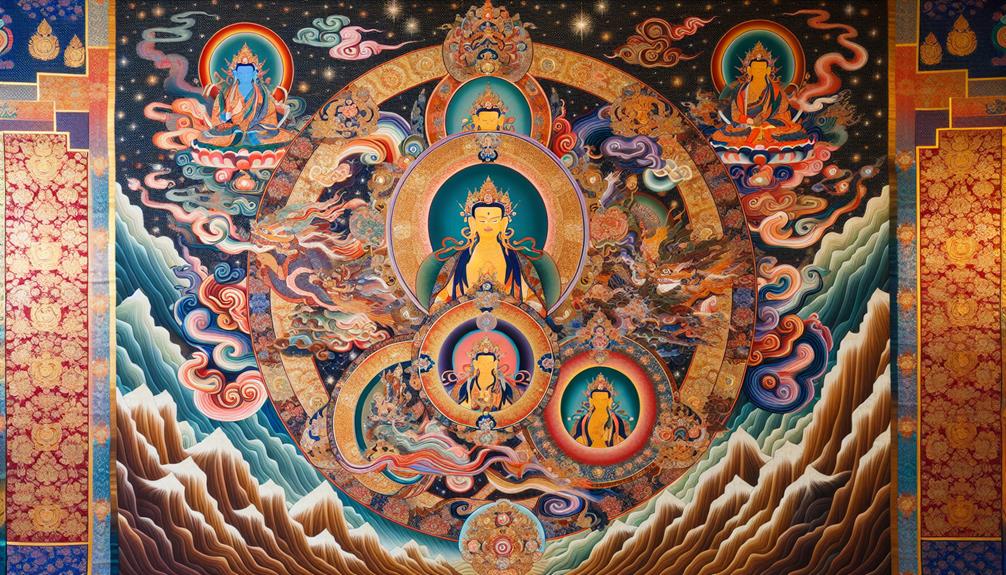As you gaze upon a Tibetan Thangka, you can’t help but be drawn into its vibrant colors and intricate details, each brushstroke revealing layers of spiritual meaning. This art form, steeped in centuries of history, serves not just as decoration but as a meditative Guide, inviting you to explore the profound teachings of Buddhism. You’ll discover how the symbols and techniques reflect the essence of Tibetan culture, sparking curiosity about their origins and significance. What stories lie behind each carefully painted figure, and how do they connect to the spiritual journey of those who create and contemplate them?

Origins of Thangka Art
Have you ever wondered how the intricate art of Thangka originated in Tibet? This fascinating form of painting traces its roots back to the early Buddhist traditions that flourished in the region during the 7th century.
Initially, Thangkas served as visual aids for teaching and meditation, helping practitioners grasp complex spiritual concepts. Monks meticulously painted these scrolls, often depicting deities, mandalas, and significant events from the life of the Buddha.
As you probe deeper into its history, you’ll discover that Thangka art evolved alongside Tibetan Buddhism, influenced by various cultural exchanges with neighboring regions. The vibrant colors and intricate details reflect the rich spiritual symbolism inherent in Tibetan culture. Each brushstroke carries meaning, capturing the essence of Tibetan spirituality.
Over the centuries, Thangka became not only a religious tool but also a cherished form of artistic expression. Artists developed unique techniques, using natural pigments and handmade cotton or silk to create lasting masterpieces. So, when you gaze upon a Thangka, you’re not just admiring a beautiful painting; you’re witnessing a centuries-old tradition that embodies the soul of Tibetan heritage.
Cultural Significance in Tibet
Thangka art holds profound cultural significance in Tibet, serving as a Bridge between the spiritual and the everyday lives of its people. When you step into a Tibetan home, you’re likely to find these vibrant scrolls adorning the walls, each telling a story that resonates deeply within the Community.
They aren’t just decorations; they’re spiritual guides that inspire devotion and contemplation.
Thangkas play a pivotal role in religious ceremonies and festivals, providing a visual narrative that connects the physical world to the divine. Each figure, from deities to bodhisattvas, embodies values like compassion and wisdom, influencing daily behavior and ethical choices.
As you engage with these artworks, you’ll realize they serve as teaching tools, reminding you of the path to enlightenment.
Thangka painting is often a communal activity, fostering a sense of belonging among artists and patrons alike. In this way, they’re more than mere art; they’re a living tradition that nurtures cultural identity.
Artistic Techniques and Symbolism
Exploring the intricate artistic techniques and rich symbolism of thangka art reveals how each brushstroke and color choice conveys profound spiritual meanings and cultural narratives.
Artists use natural materials like mineral pigments and handmade paper, ensuring that every piece isn’t only visually stunning but also deeply connected to Tibetan traditions.
The meticulous process begins with sketching, followed by layering vibrant colors to create depth and emotion.
Each color holds specific significance; for instance, red symbolizes power and transformation, while blue promotes healing and tranquility.
You’ll notice that the figures depicted often embody different aspects of Buddhist teachings, from compassion to wisdom.
The intricate details in the clothing and backgrounds further enrich the narrative, inviting you to explore deeper meanings.
Moreover, thangka artists employ a technique called “gilding,” where gold leaf accents enhance the spiritual essence of the artwork.
This attention to detail transforms each thangka into a sacred object, meant for meditation and contemplation.
As you appreciate the artistry, you’ll find yourself drawn into a spiritual journey that transcends mere aesthetics, opening a door to the rich tapestry of Tibetan culture and belief.
Continue Your Exploration: Tibetan Thangka Art
The intricate beauty of Tibetan Thangka art encapsulates a rich spiritual journey, intertwining artistic mastery with deep religious symbolism. Each piece reflects the profound cultural and spiritual heritage of Tibetan Buddhism, offering insights into its meditative and devotional practices. To delve deeper into the captivating world of Tibetan Thangka art, we invite you to read a detailed article on Tibetan Thangka art. This comprehensive piece provides an in-depth exploration of its history, techniques, and spiritual significance.

